Why I Bought It: Vintage JDM Seiko 7002 Diver And A Same-Vintage Honda Beat (Archive)
In my watch enthusiast life, I spend more time learning about the mechanics and trying my hand at making similar things than buying watches. In fact, over the past few years many watches in my collection have slowly been sold to finance the purchase of tools and equipment, which allow me the ability to create things that will hopefully bring me one step closer to my dream of creating my own watch from the ground up.
Yet I still have numerous watch desires and a very long list of pieces I hope to add to my collection someday. Many are, and will most certainly always be, beyond my reach for a multitude of reasons. But there are others within my reach, and today I’ll discuss my latest acquisition and why I bought it – and a vintage watch at that.
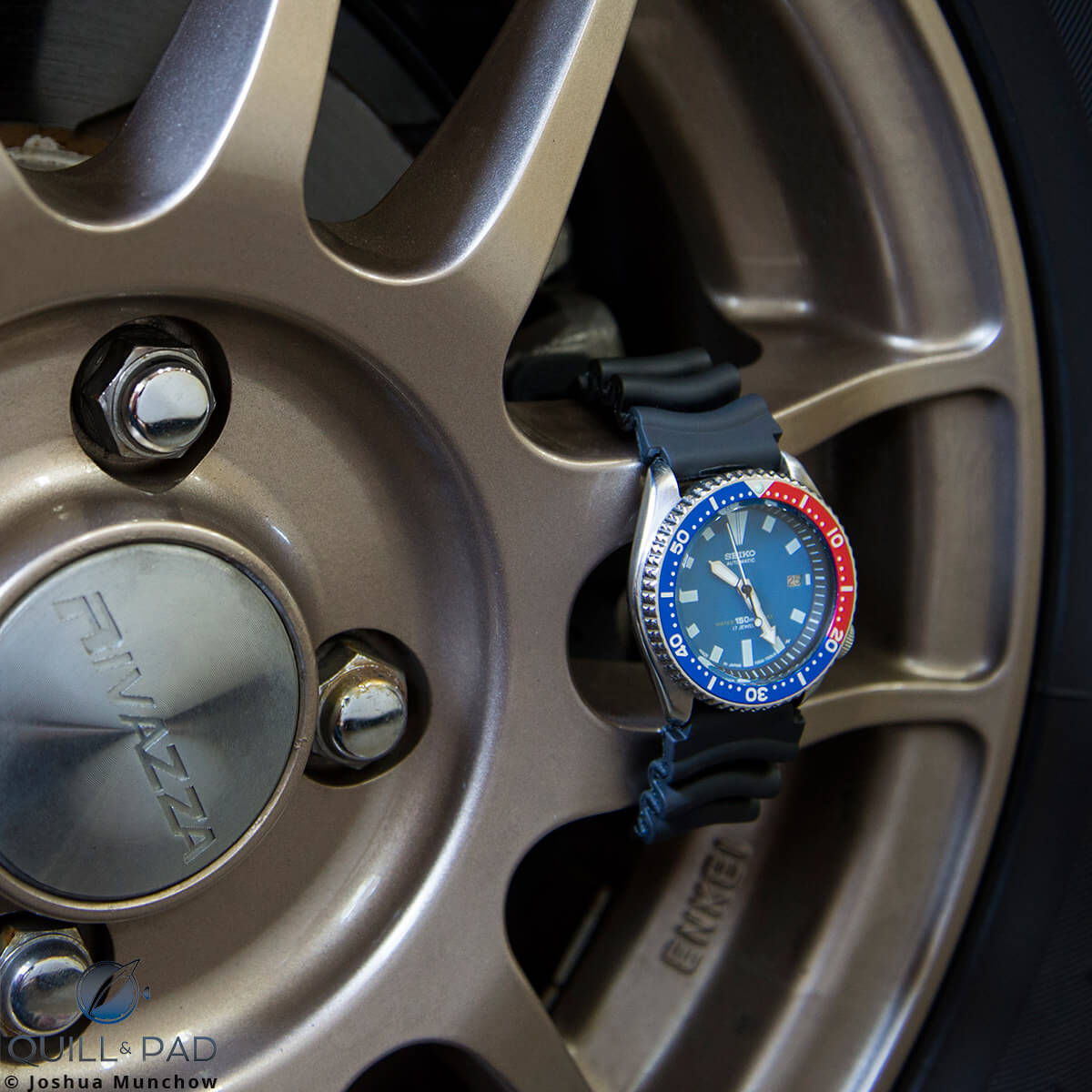
The author’s vintage Seiko 7002 Diver
The accidental beginnings
I spend a lot of time writing about watches and have been extremely lucky to get the opportunity to handle some very coveted pieces over the last few years, sometimes handed to me by collectors, CEOs, or even rock-star watchmakers. So in a multitude of ways, my watch-nerd itch gets scratched fairly regularly. I am rarely left “watchless” for long periods of time.
I have my own personal watches and I get to test drive others from time to time. This is why I feel a bit more at ease spending my savings on tools and equipment to build watches instead of spending it on watches themselves.
But as I have covered the world of watches, another of my dormant passions has been reignited thanks to opportunities afforded me by great people and generous brands. That passion is automobiles. Most enthusiasts agree that watches and cars go together, so it is no surprise that I have a strong interest in fast things with powerful motors.
In March of 2016 that interest caught fire like it hadn’t since I was in high school.
The beginning of the journey starts with a good friend of mine who co-owns Montu Motors, which imports Japanese cars and focuses on high-performance vehicles like the Nissan Skyline and Honda NSX.
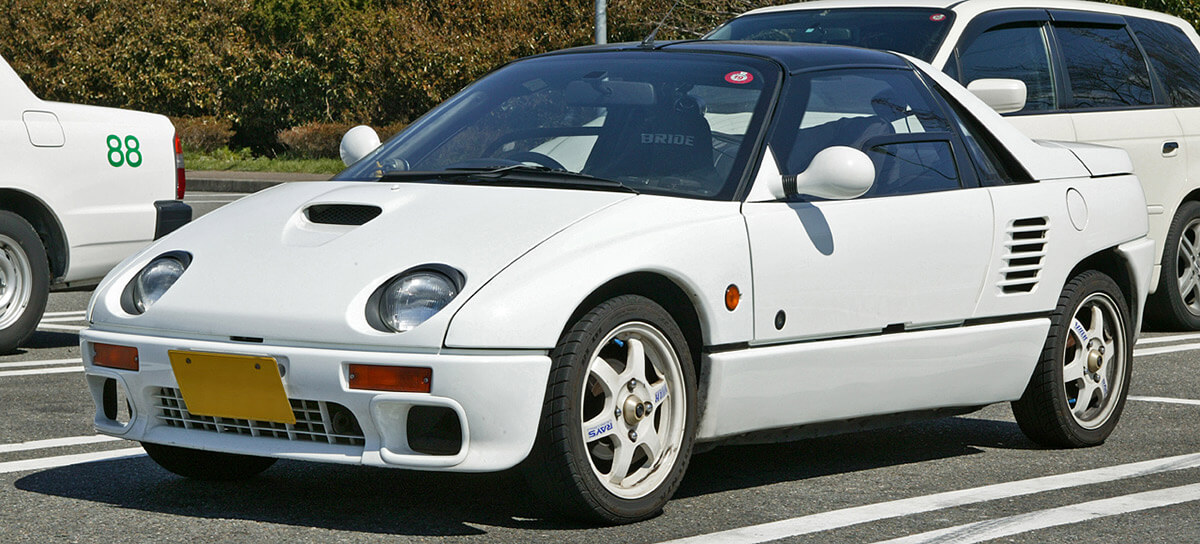
Autozam AZ-1 (photo courtesy Tennen Gas)
In March I got word that his company had a new shipment on its way with a couple of JDM (“Japanese domestic market”) Kei cars, one of which had been a dream of mine to own for a while. For non-Japanese fanatics, Kei cars, or kei jidosha, are a special class of micro cars sold only in Japan for use in congested cities; in the early 1990s there were three sports car versions that gained a cult following around the world: the Autozam AZ-1, the Suzuki Cappuccino, and the Honda Beat.
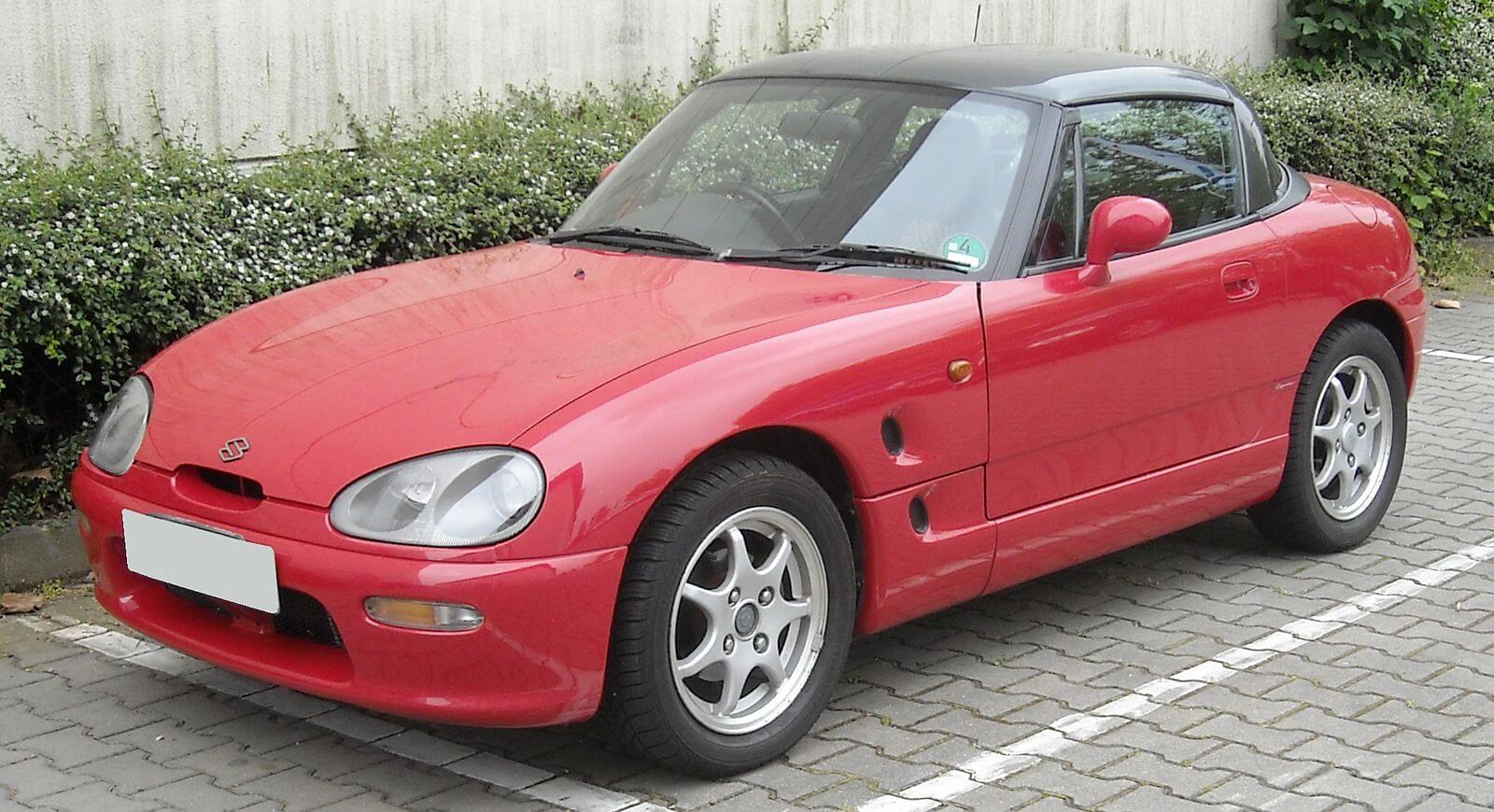
Suzuki Cappuccino (photo courtesy Rudolf Stricker)
Being a Honda fan and a bit of a purist, I gravitated toward the Honda Beat, which is a mid-engine, rear wheel drive, normally aspirated, high-revving sport coupe that you can pretty much fit in your pocket. Montu Motors had two Honda Beats coming in, and my friend invited me to his shop in Tampa, Florida to test drive them.
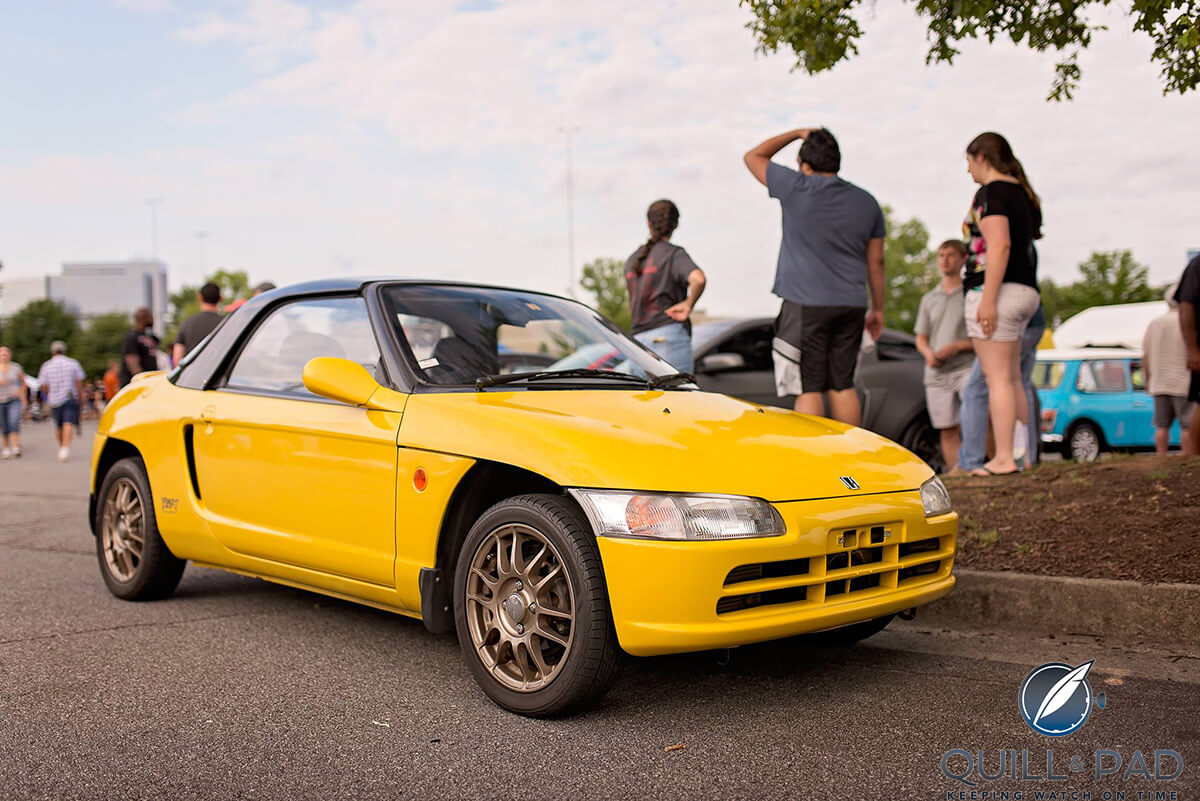
The author’s bright yellow Honda Beat (photo courtesy David New, www.davidnew.net)
One week after their arrival at the end of May, three friends and I were on our way from Atlanta to test drive some of his inventory, with my main focus to discover what the Honda Beat was really like.
Love . . . and waiting
It was love at first shift.
I have always loved small things, and sitting in that tiny Kei sports car cemented the idea that I definitely wanted to have one. Upon talking with my friend I was surprised to learn that buying one might actually be within reach, and so I set him to the task of finding one with some specific features. He said he’d let me know if he found anything and I headed home with my fingers crossed.
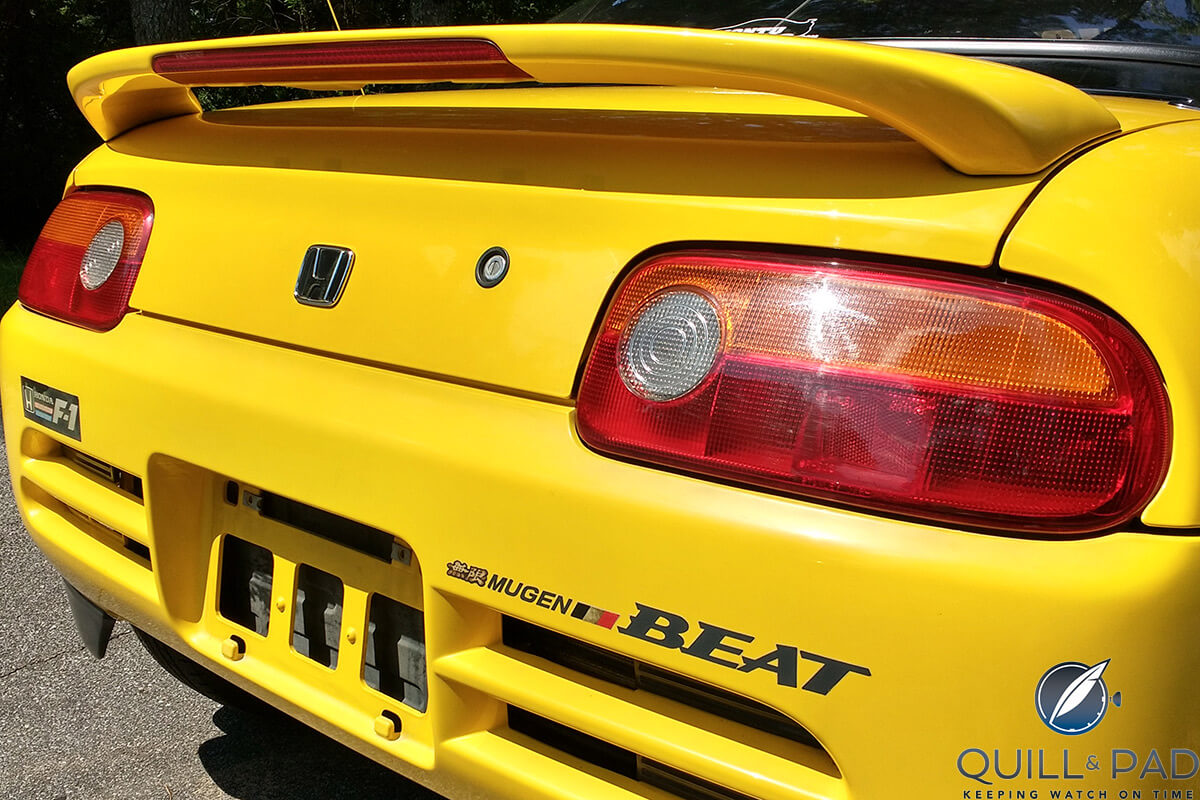
Back of the author’s Honda Beat
Less than a week later he emailed me a couple photos of one he’d found, and I instantly knew that it was my future car. I gave the go ahead and the import process began.
That process ended up being the longest two-month wait I’ve had since I was a child dressed up at Halloween already waiting for Christmas. And, wouldn’t you know, waiting can do strange things to a person, including convincing you that your dry spell of no-watch-buying is over.
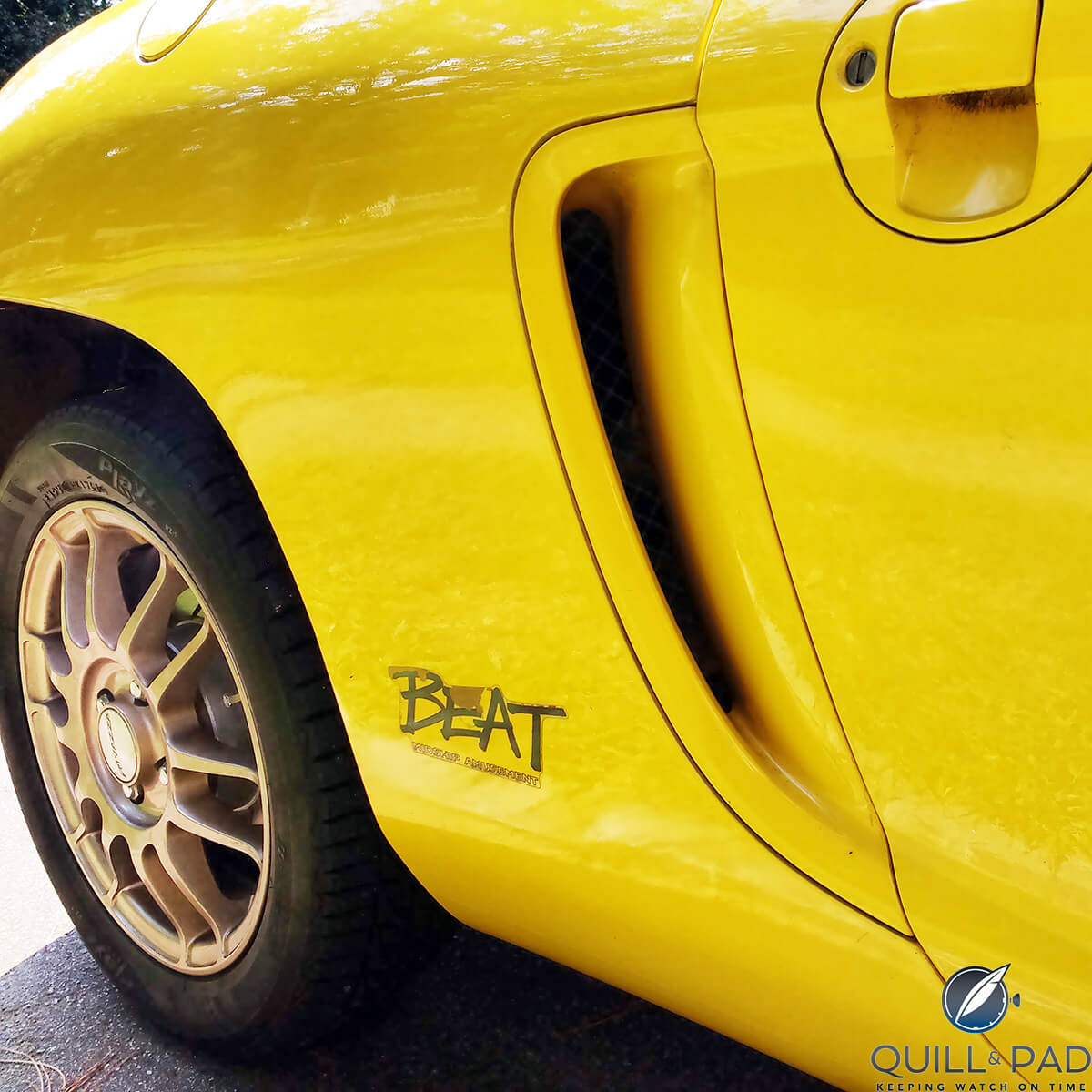
The author’s Honda Beat rear wheel vent
Japanese, please
If it hasn’t become clear to you by now, I am a bit of a Japanophile. The reasons are varied, but the ingenuity and creativity that has come out of that country throughout history is amazing – especially over the last 70 years, which have been astonishing.
Japan is a leader in engineering and craftsmanship, and its watchmaking is absolutely top notch (just ask Philippe Dufour).
When it finally hit me that I was really and truly buying a JDM car, I decided that I needed to mark the occasion with a watch following that Japanese theme. With funds growing thin, there was only one smart decision to make: which Seiko would I buy?
Out of all the Japanese watches, Seiko still reigns supreme when it comes to value and quality. The number of Seiko fans around the world rivals many Swiss brands.

The author’s Seiko 7002 Diver ready to race
The holy grail of Seiko is the exquisite Grand Seiko (see Grand Seiko: Already Big In Japan And Getting Bigger Near You), but nearly equally as popular diver’s collections are where it’s at for me. I absolutely love Seiko dive watches, though I actually lean toward the brand’s older diver styles because they feel to me more restrained and classic in their intent.
This meant that I would definitely be buying used, but there was another criterion that was much nerdier: I intended to get a watch that was made in the same year of the car I had just sourced from Yokohama.
I know, huge nerd.
The soon-to-be-mine Honda Beat was built in 1991, so this narrowed my search down dramatically to the Seiko 7002 series.
Luck and realistic goals
Through research I discovered that there was one specific version of the first generation 7002 diver that was a Japanese home-market version with case number 7002-700J, which included the popular “Pepsi” bezel. While I doubted I could actually find one, this meant that with a great bit of luck I might actually be able to source a 1991 JDM Seiko diver to go with my new 1991 JDM Honda Beat.
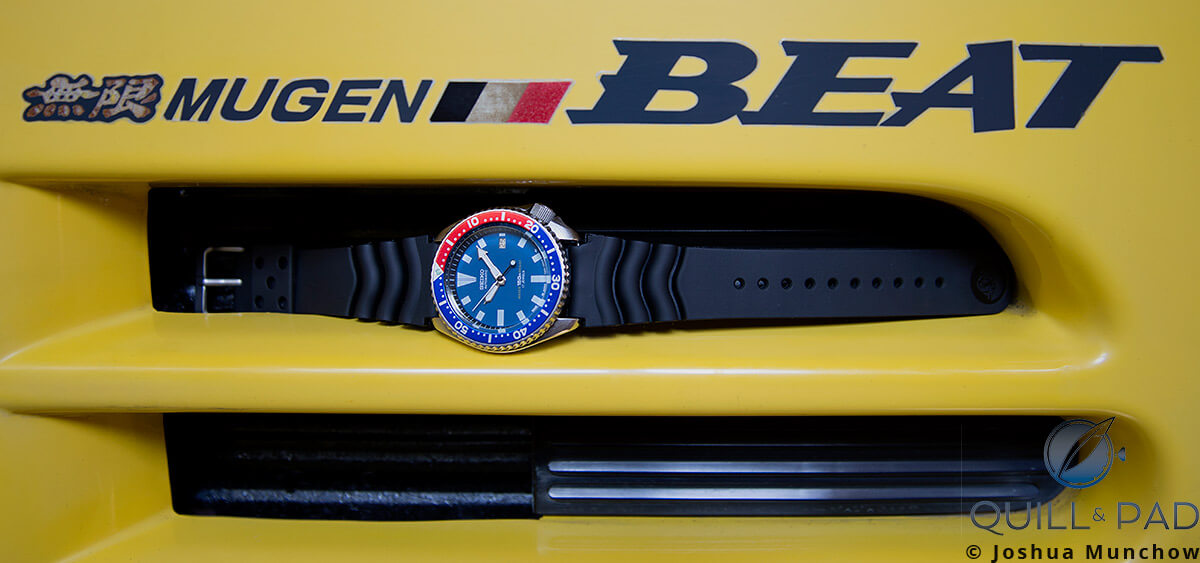
The author’s Seiko 7002 Diver nestled in an air vent of his Honda Beat
I also realized that since I wanted a very specific model I had to be realistic about how long it might take to find, and that the condition of such a specific watch could prove to be my downfall.
As it turns out, Ebay can sometimes be your best friend. By sheer luck I was able to find two 7002-700J examples, and after cross referencing the serial numbers, I found that one of them was actually manufactured in August of 1991!
It also looked to be in rather good shape so I was a bit wary that it was too good to be true. I contacted the seller to ask questions and it turns out he restores vintage Seikos.
Restored. Now that is a word that makes most watch collectors cringe in fear. The word “restored” usually means “replaced parts by unqualified watchmakers” and, as a result, a complete loss of any value. People fear the frankenwatch – and for good reason.
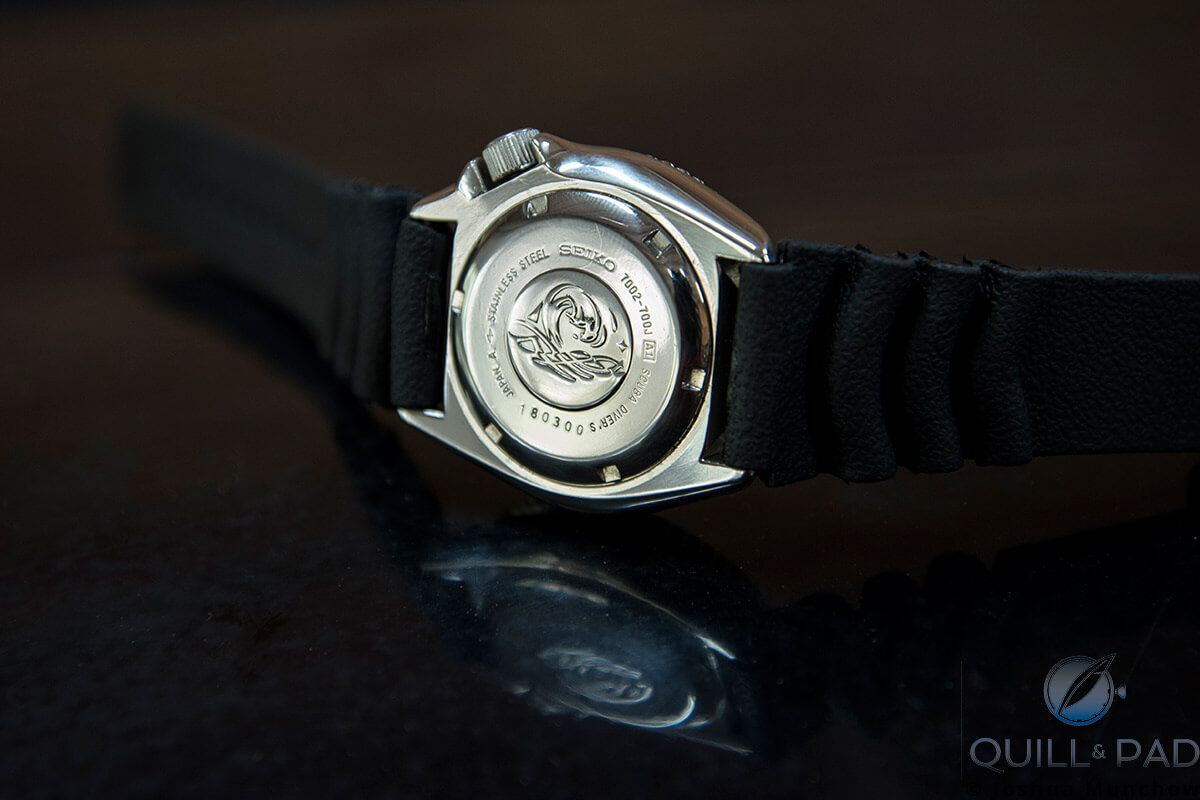
The back of the author’s Seiko 7002 Diver
But for a watch that started out as an inexpensive diver, and was considered a bit of a beater by now, I was actually pretty happy to see that word.
Vintage watch collecting is a dicey prospect, and perceived value is, above all, the most contested aspect of a purchase. But I didn’t set out to buy a 7002 diver as an investment piece or even as something I hope to pass on as a prime example of Japanese watchmaking. I wanted one for what it was: a sturdy, awesome-looking diver’s watch that could turn some heads and, as an added bonus, share a bit of history with my new car.
I just wanted a good watch.
The seller informed me that he has a professional watchmaker servicing and restoring the watches to OEM specifications. For this specific watch the dial, hands, and bezel insert had been replaced with OEM and direct replacement parts, the case had been re-polished (though it did not experience a complete case refinishing), and the movement had been fully serviced but was still completely original.
This meant it looked great and worked great, but more importantly, I didn’t have to worry about destroying the value of a pristine vintage example. It was actually perfect for me.
Ready and waiting to be upgraded, restored, modified, and used for its original purpose
I like to wear my watches. I will try my best to keep my dress watches from getting scratches, and I definitely don’t abuse them. But I do wear a couple of my watches in the shop under all conditions and I use them as the tools that they are.
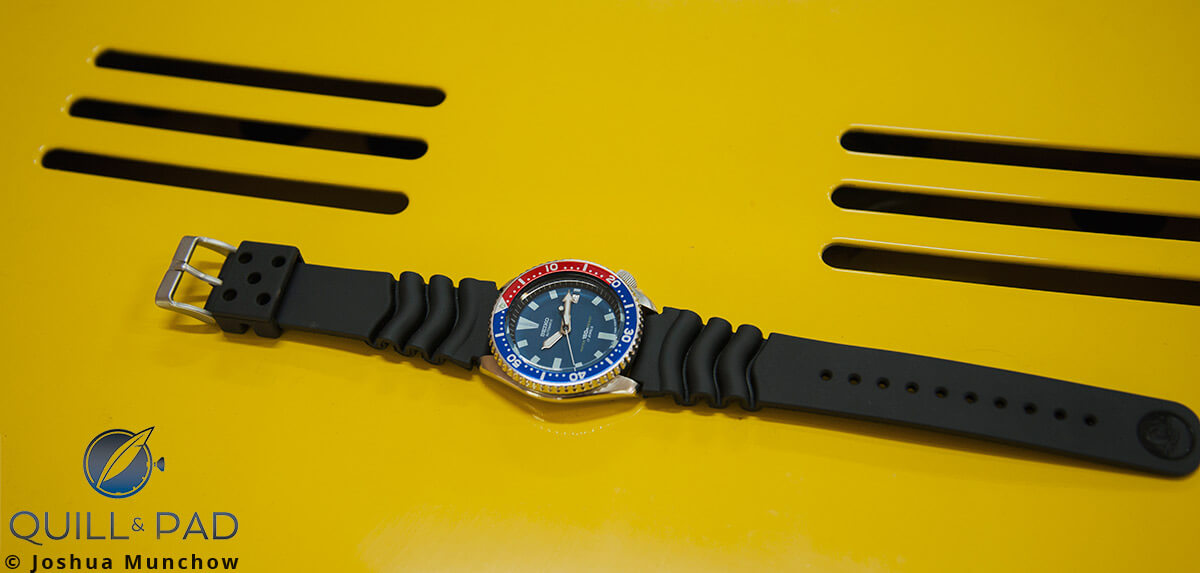
The author’s Seiko 7002 Diver
When I found this watch and learned about the replacement parts, I realized that it meant that I could wear it without fear and actually enjoy the watch. I bought the watch because it was a piece that had been loved enough to last 25 years and respected enough to have time and effort put into it to resurrect it to its former glory.
And now that I own it, it will have another life with another enthusiast.
My Honda Beat is a somewhat rare car in the U.S., but it came with modifications and I will treat it like the machine it is, ready and waiting to be upgraded, restored, modified, and used for its original purpose.
The same goes for the Seiko 7002-700J. It is a tool watch, something that is inexpensive enough to be used without fear and nice enough to be worn for many occasions – like while driving a vintage JDM Kei car.
But don’t think that I don’t care about details. Eagle-eyed Seiko savants might notice that the color of the dial is a lighter blue than the original, and the words “Water Resist” are in a greenish-grey and not the original orange. To some, that is a deal-breaker. For me, it’s something that adds to the story of the watch.
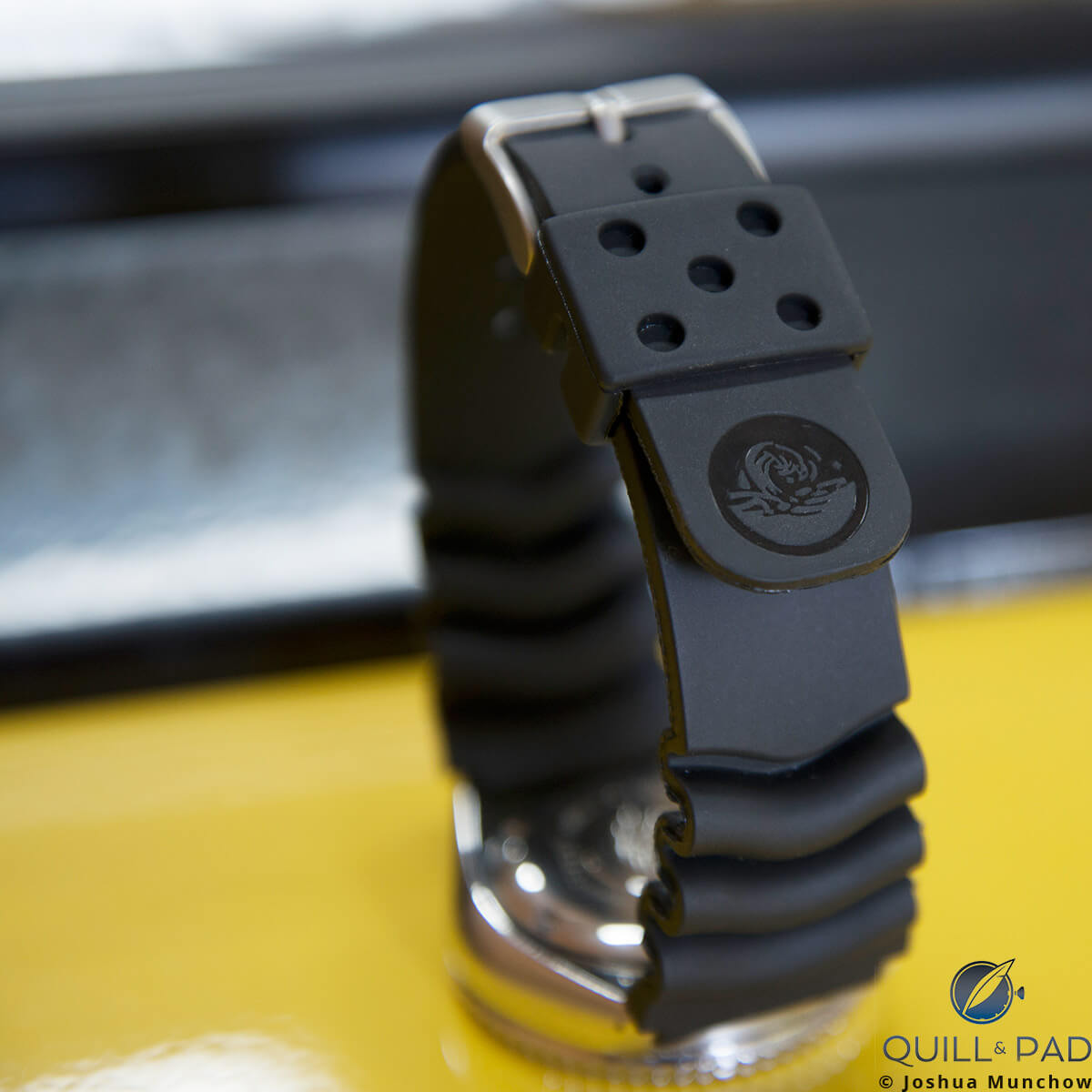
Thick rubber strap of the author’s Seiko 7002 Diver
It wears incredibly well, and it’s already been commented on by people who, upon further discussion, either know a lot about watches, or not much at all. One thing they all had in common was that no one cared that it was restored; they simply enjoyed it as a cool watch.
What it means to me
And that is another reason I love watches, the shared enjoyment. Having something be completely original in nearly mint condition with original box and papers is a pretty cool thing. And if that watch happens to be a vintage LeCoultre Deep Sea Alarm, all the better.
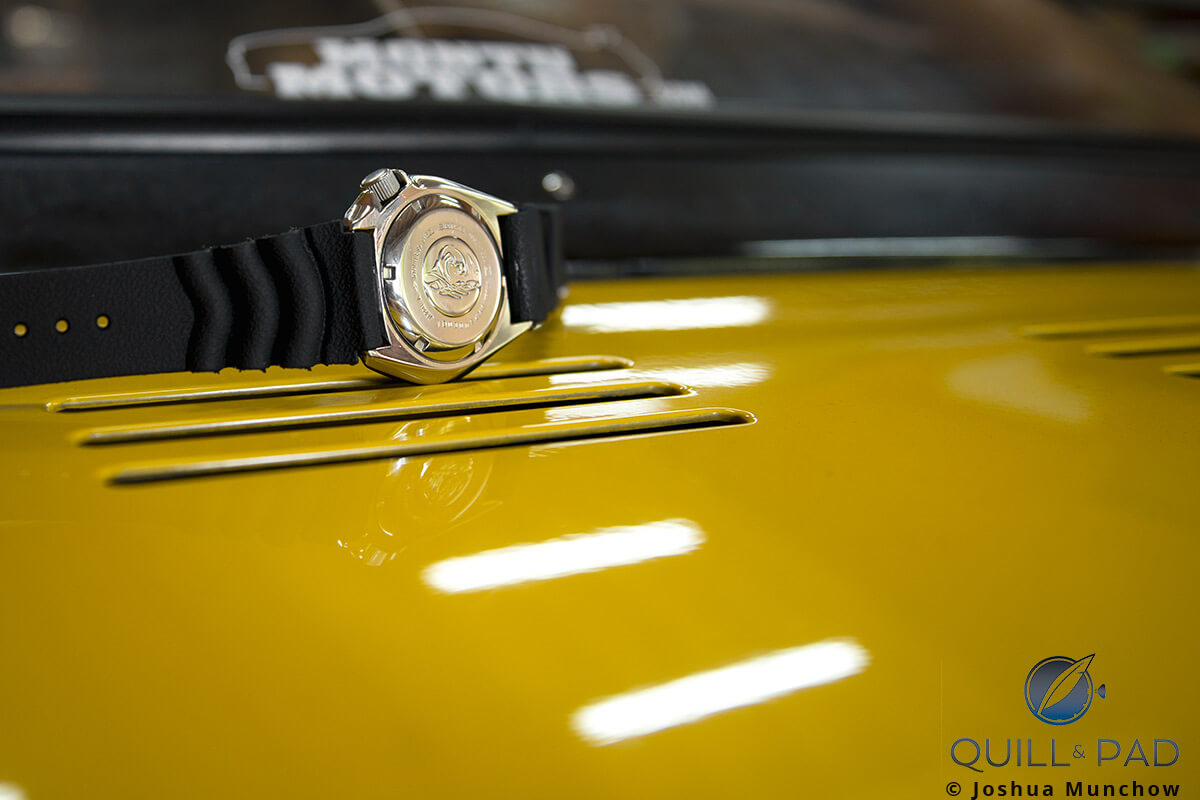
Back of the Seiko 7002 Diver
But based on other watches I have owned, it doesn’t really add to the joy of wearing a watch. And those who aren’t hardcore vintage collectors wouldn’t even know the difference. Seeing the watch on your wrist, loving to look at it, talking about it with other people, and feeling like you got exactly what you wanted is the true pleasure.
So now I wear the watch whenever I drive my Honda Beat, and when I simply want a sweet-looking diver on my wrist.
I don’t plan on taking it diving, but that isn’t the point. Having a JDM “Pepsi” Seiko 7002 is awesome, and knowing that it shares its birth year with my other JDM find is even better. I didn’t have to justify my purchase based on which precious metal was used, how many were made, or whether or not it is holding its value at auction.
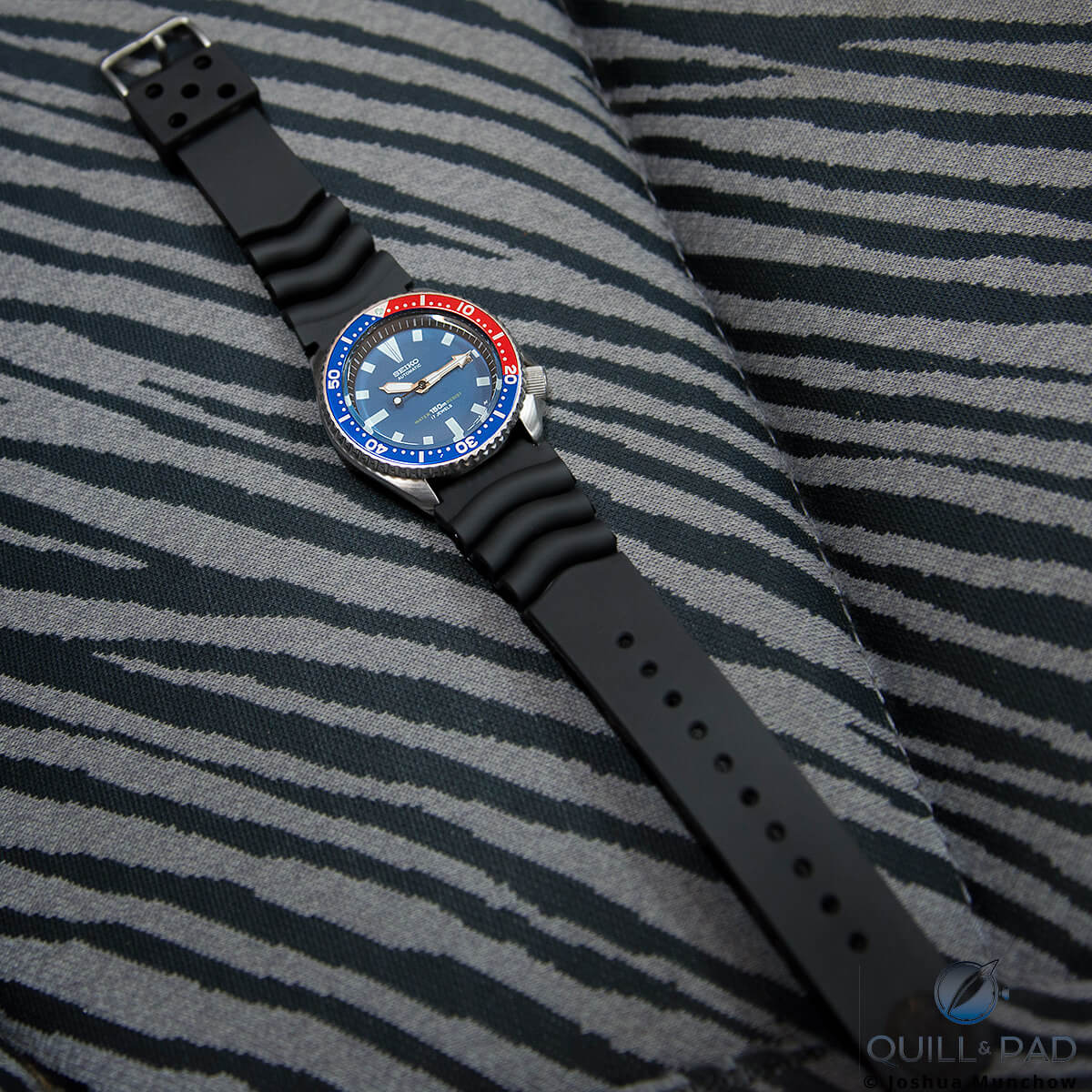
The author’s Seiko 7002 Diver
Clearly I know it isn’t on the same level as a Vianney Halter Deep Space Tourbillon or a Greubel Forsey Invention Piece 1 (oh, so many objects of desire! GaryG, I envy you!), but it is a part of my collection and will be as long as I have the car. They are a pair, and they both suit me well.
As pedestrian as they may be to the wealthy car and watch enthusiasts out there, I’m going to enjoy the living heck out of them! And I hope you all do the same with the items you are passionate about. Because in the end that’s what any type of collecting is about: your passion.
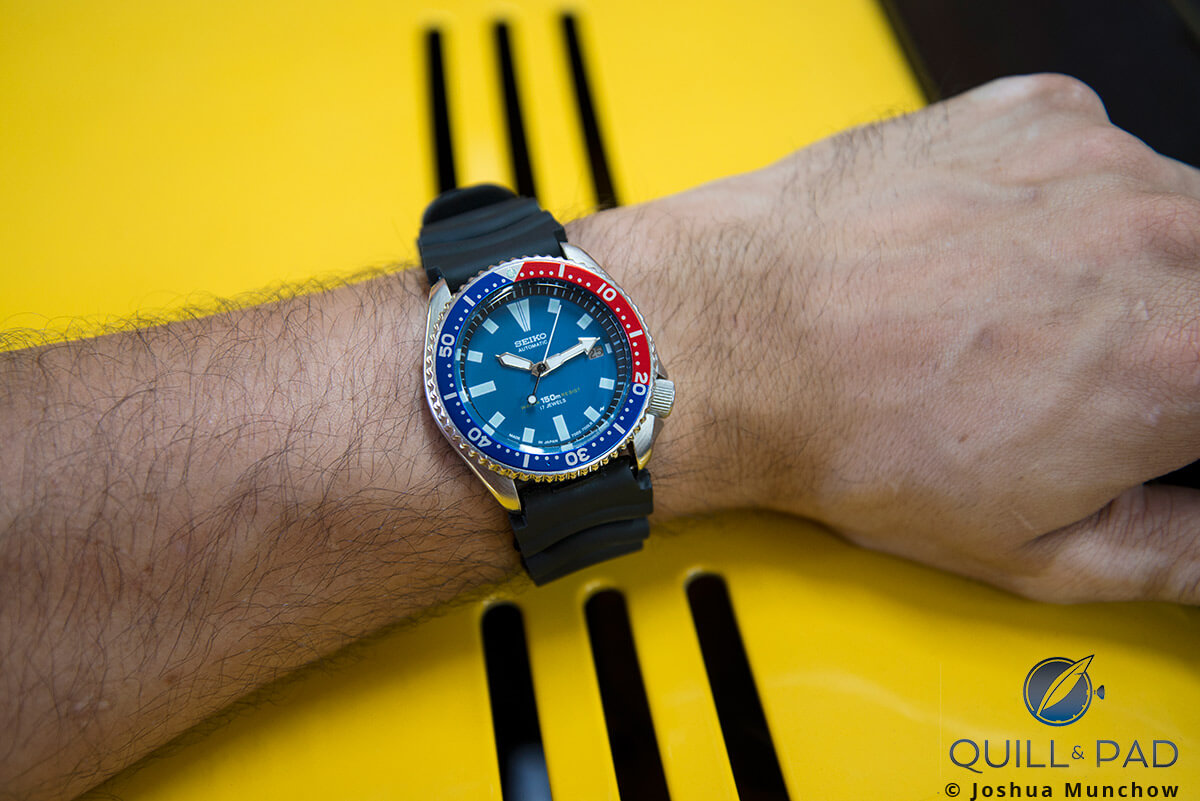
Seiko 7002 Diver on the author’s wrist
Stay passionate, my friends!
Quick Facts
Case: 41 x 13 mm, stainless steel, water-resistant to 150 m
Movement: automatic Seiko Caliber 7002A
Functions: hours, minutes, seconds; date
Price: good examples can be found from $150 – $200 on the pre-owned and vintage market
Year of manufacture: 1991
*This article was first published on October 2, 2016 at Why I Bought It: Vintage JDM Seiko 7002 Diver (Plus A Same-Vintage Honda Beat).





















































I had that same Beat in fire engine red while living in Japan in the early 90s. I loved it as much or more than any car I’ve owned since. The tiny, sporty body, the drop top I could put down at a red light without unbuckling my seatbelt and, of course, that delicious noise that came with high RPMs. It sounded like an F1 car to me at the time and I’ve missed her ever since we parted ways.
A great, well-written story! I too have thought about the cultural connection between the Japanese cars I own and love (1999 Miata MX-5 and 2017 Honda Civic Si) and my first mechanical watch (Seiko SKX009). All three embody an ethos that mixes elements of great engineering, value, and functional, beautiful design meeting performance. All three can really be used, and used hard, as reliability and durability are part of their DNA. I appreciate how you tried to articulate the passion behind acquiring things that may not cost a lot, things that were industrially produced, but are still objects that capture and hold the “anima” or spirit of your passions. It’s fun to read about exotic cars and watches, but one has to respect the designers and companies who can produce such wonderful, classic products that are actually affordable for the average person. Bravo!
Josh,
Loved the writing. I have a 7002-700x from the same time frame. It’s first 10 years were worn in Hawaii for whatever water activities I got into. I’ve worn it on and off since. I’ve had various bands on it. I went through a couple Waterborne bands. It is currently mated to a Don Juan stainless steel band/cuff. I’m sure it could use some maintenance. Would you be so kind as to give me your “restorer” contact info?
I pulled into Japan numerous times in early 90’s and had some fun rides in a few Kei cars. A friend had something that looked liked like a Miata, but had “Premio” emblem on the rear. That was a fun sporty/commuter to putter around.
Thanks.
V/R
John
I’ve seen the smaller JDM cars have great use in places like California. The cost of Gas and population demands a smaller vehicle. I love the idea of micro-cars. I remember I had a friend that would purchase every Toyota 4 cylinder truck he could get his hands on. They are still in high demand out west. Awesome information! I’ve always loved watches but don’t have the budget for the more top quality models.
As I have secured the universe of watches, another of my torpid interests has been reignited. That energy is autos. Watches and vehicles go together, so it is nothing unexpected that I have a solid enthusiasm for quick things with incredible engines. This is the account of how I wound up with both a 1991 Honda Beat and a 1991 Seiko 7002 Jumper. I’m despite everything grinning So click here for more information.